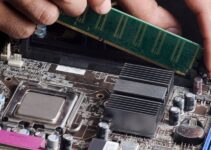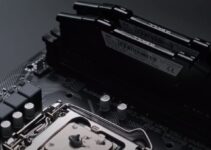Is 128gb RAM Enough for Business Student Laptops? The storage capacity required for a laptop varies based on the user’s individual needs. It means that answer of the question ‘Is 128GB Ram enough for Business Students Laptops? varies from person to person.
The reason is everyone will use the device as per its own study and needs, priority. Some of them may be entrepreneur other may be employee and someone may be handling family business while other could be internees somewhere. For business students, 128GB of storage should suffice, but for users who frequently edit videos or play games, more space may be necessary.
It’s important to consider the type of work or activities that will be done on the laptop when determining the appropriate storage capacity. While 128GB RAM is typically enough for web browsing and email, power users who work with large files or storage-intensive applications may need more space.
Ultimately, the amount of storage needed depends on the individual user’s needs and usage patterns.
What is the RAM

Function and Advantages of RAM
RAM is the hardware component in a computer where the operating system (OS), application programs, and currently used data are stored for quick access by the device’s processor. RAM serves as the computer’s main memory and enables faster read and write operations compared to hard disc drives (HDDs), solid-state drives (SSDs), or optical drives.
Volatile Nature of RAM
Random Access Memory (RAM) is volatile, which means that the data stored in it is retained only as long as the computer is on and is lost when the computer is turned off. When the computer is turned back on, the OS and other files are typically reloaded from an HDD or SSD into RAM.
What Can a 128GB SSD Laptop for Business Students Hold?
Despite its relatively small size, a 128GB SSD can hold a considerable amount of information for a business student. These are the types of files that a student might store on their laptop:
- Computer programs
- Operating system (OS)
- School books (PDFs)
- Course notes (Word documents)
- Presentations (PowerPoint files)
- Project files (Word documents)
All of these files are relatively small, and can be compressed into ZIP files or folders to save space on the SSD. By doing so, students can maximize their storage capacity for other data.
RAM and Memory Comparison

RAM cannot store permanent data because it undergoes constant changes. A person’s short-term memory can be compared to RAM, while their long-term memory can be likened to a hard disc drive.
Short-term memory is used for immediate tasks but can only hold a limited number of facts at once. When a person’s short-term memory reaches its limit, information stored in their long-term memory can be used to replenish it.
Similarly, when a computer’s RAM is full, its processor has to access the hard drive repeatedly to overwrite old data in RAM with new data. This process slows down the computer’s performance.
RAM and the Concept of Random Access
How Does RAM Work?
- RAM has the ability to directly access any storage location or “memory address.
- The term “Random Access Memory” was used to distinguish it from “core memory” and “offline memory.”
- Offline memory, such as magnetic tape, could only be accessed sequentially by finding the address in order, starting from the beginning of the tape.
- RAM is designed to enable direct storage and retrieval of data from specific locations.
RAM vs Other Storage Types
- Other types of storage can be accessed randomly, but they are not called “random access” memory.
- RAM is like a group of boxes where each box represents a cell that can hold a 0 or 1.
- Each cell has a unique address that can be located by counting the rows and columns of the array.
- The RAM controller sends the row and column address along electrical lines etched into the chip to locate a specific cell.
- Any read data flows back on a separate data line.
Installation and Limits of RAM
- Memory modules consist of RAM microchips inserted into slots on the motherboard.
- Slots are connected to the processor by a bus, a set of electrical paths.
- Adding RAM modules can reduce the amount of data the processor reads from the hard drive.
- RAM access time is measured in nanoseconds.
- Storage memory access time is measured in milliseconds.
History of RAM: RAM vs. SDRAM
Problem with Asynchronous RAM: RAM used to be asynchronous, because the microchips that made up RAM ran at a different speed than the processor. This became a problem, as processors got faster and RAM couldn’t keep up with all the data requests from the processor.
Syncing RAM Clock Speed: When synchronous dynamic RAM, or SDRAM, came out in the early 1990s, clock speeds were made to match. By synchronizing a computer’s memory with the processor’s clock speed, tasks could be done faster.
Limitations of Single Data Rate: The single data rate SDRAM (SDR SDRAM) that was used at first quickly reached its limit. Double data rate synchronous Random Access Memory (DDR SRAM) was introduced around the year 2000. This moved data at the beginning and end of a single clock cycle.
Evolution and Compatibility of DDR SDRAM: DDR SDRAM has since gone through three iterations, with DDR2, DDR3, and DDR4. Each version has been faster and more energy-efficient than the previous one. However, each new version of DDR has been incompatible with previous versions because of the handling of data in larger batches.
Types of RAM
There are two main types of RAMS available:
Dynamic Random Access Memory (DRAM)
RAM is usually made up of Dynamic Random Access Memory (DRAM), and as previously mentioned, it needs to be powered on to retain the data it stores.
A capacitor stores the amount of charge or lack of charge in each DRAM cell. To compensate for leaks from the capacitor, this data must be refreshed with an electronic charge every few milliseconds.
A transistor acts as a gate that allows you to read or write the value of a capacitor.
Static Random Access Memory (SRAM)
Static Random Access Memory (SRAM) also requires constant power to keep data, but unlike DRAM, it doesn’t need to be continually refreshed.
In SRAM, the transistor acts as a switch instead of a capacitor to hold the charge. One position represents a 1 and the other a 0.
Unlike dynamic RAM, which only needs one transistor per bit, static RAM needs more than one transistor to store one bit of data. Because of this, an equivalent amount of SRAM is much larger and more expensive than an equivalent amount of DRAM.
FAQs: Is 128gb RAM Enough for Business Student Laptops
Is 128GB SSD Enough for Laptops and Desktops with Windows 10?
Windows 10 can run on a 128GB SSD, but that’s not a lot of space. Since the operating system takes up about 20GB, you have about 108GB left for other programs and files.
If you plan to install a lot of games or use the computer to edit and create media, 128GB might not be enough. But 128GB is more than enough for most people if all they do with their computer is surf the web, check their email, and write documents.
How Much SSD Does a Student Need?
First, you should know that you don’t need much disk space. Backblaze, an online backup service, says that the average computer user in the United States has about 500 GB of data. This number can be even less for students.
For example, if you only use your computer to store photos and music, you may only need 30 to 40 gigabytes of storage space. At the prices we have now, that’s less than $50 worth of hard drive space.
If you’re using an SSD for video editing or gaming, you should look for at least 250 GB of space, but 500 GB or 1 TB is better. But these days, most laptops already have 256 GB or 512 GB of SSD storage built-in.
Does 1TB Beat 128GB SSD?
Yes, but only if you plan to upgrade your computer at some point in the future. If all you want is to make your current system run faster, a solid-state drive (SSD) is a better option. This is why:
SSDs have always been more expensive than HDDs, but as SSDs get cheaper and HDDs get faster, the price difference is getting smaller. In fact, the price difference between 1TB hard drives and 128GB SSDs has gone from about $1 per gigabyte in 2013 to less than $0.50 today. This doesn’t even take into account how much faster SSDs are than HDDs.
Is an SSD with 128GB Enough?
If you want a laptop with a lot of space to store things, 128GB is not enough. If your laptop has at least 256GB SSD, it will be able to hold all of your important files.
If you don’t want to give up any performance on your laptop, you can choose an SSD with 512GB or even more. But a 128GB SSD would be enough if you want a cheap laptop and are willing to spend less money on it.
What is the best amount of RAM for a computer used for business?
8GB: Most PCs for students and businesses could do everything they need to do with 8GBs of RAM. There will be no input lag when running multiple light programs and a web browser at the same time. Depending on the graphics card and processor in the machine, some games will also work with 8GB.
How much memory (RAM) does a student in business need?
Most people who spend $500 or more on a laptop should try to get at least 8GB of RAM. We usually recommend this amount of memory for most users who work in an office or do other common tasks, as well as for gamers, especially if you are considering a model with RAM that is soldered and can’t be updated later.
Is 128GB of memory on a laptop too much?
You might be able to get by with 128GB, but if you can afford more, it’s probably better to be safe than sorry. It’s hard to add more space to a laptop, but you can buy an external drive to use as a backup or even as daily storage. However, this will make your machine bigger and make it harder to use.
Is 256GB enough for a laptop for a student?
Make sure that the storage space is enough. At least 256GB will be enough. You’ll have enough room for all of your photos and school files.
How many GB should a college student have?
A high school student probably wouldn’t need more than 256GB to 512GB. Depending on what the student plans to study in college, the laptop will need more or less space.
Does school work fit on 128GB? Also, 256GB is usually MORE than enough for college, especially if you don’t store a lot of movies and other things. If I got through college studying computer science and multimedia design on a 2008 Macbook with a 160GB hard drive, I don’t see why either of your choices would be a problem.
Read More:



